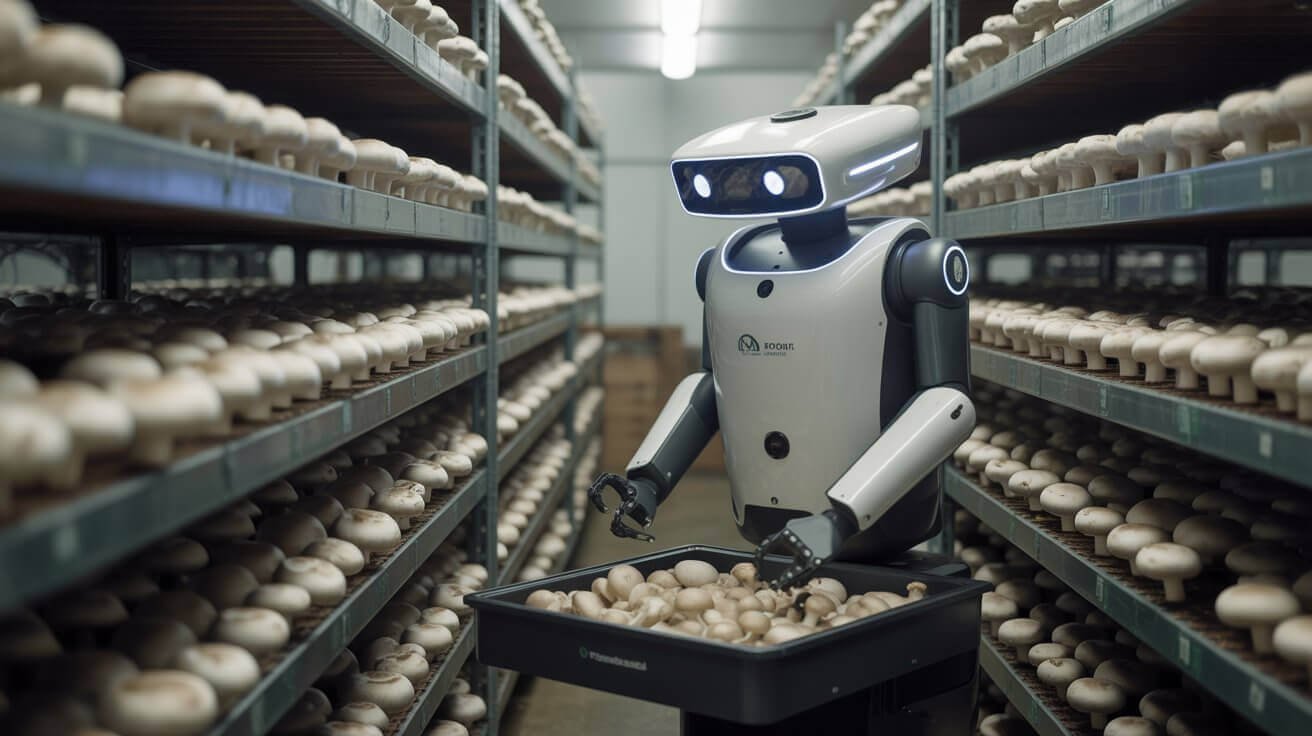Picture this: It’s 3 AM in a damp, dimly lit warehouse where mushrooms are growing faster than workers can pick them. Meanwhile, an autonomous harvesting robot named HX-400 quietly glides between shelves, using AI-powered cameras to identify the perfect mushrooms and gently pluck them with precision suction cups. It’s been working for 20 hours straight without a break, and it’ll keep going for another four.
This isn’t science fiction anymore. Autonomous harvesting robots are happening right now across farms in Canada, the U.S., Ireland, the Netherlands, and Australia. B.C.-based 4AG Robotics just secured a massive $40-million investment to expand their autonomous harvesting robots, and for good reason. The agricultural labor shortage has reached a tipping point, especially in mushroom farming where vacancy rates hit up to 20 percent. These cutting-edge autonomous harvesting robots represent the solution to agriculture’s most pressing challenge.
But here’s what’s really interesting: these robots aren’t just filling gaps—they’re fundamentally changing how we think about farming efficiency, food production, and what the future of agriculture looks like.
The Labor Crisis That’s Keeping Farmers Up at Night
Let’s talk numbers. About $200 million worth of mushrooms are wasted annually in North America due to labor shortages. That’s a staggering amount of food going to waste while grocery prices keep climbing.
The mushroom industry faces particularly brutal challenges. Workers must operate in damp, dark warehouses around the clock because mushrooms grow year-round and can double in size every 24 hours. It’s physically demanding work with high turnover rates. Many farms see turnover exceeding 40 percent, with workers often leaving before they’ve mastered the three-month learning curve.
Meanwhile, 40% of Canadian farm operators will retire by 2033, and fewer young people are entering agriculture. The result? Farmers are competing with air-conditioned jobs at McDonald’s that pay $25 an hour, while their crops literally grow past optimal harvest windows.
Why Traditional Solutions Can’t Keep Up
Traditional approaches to the labor shortage—higher wages, better working conditions, seasonal visas—haven’t solved the fundamental problem. Even when farms pay well and treat workers fairly, the physical demands of mushroom harvesting in challenging environments remain unappealing to many potential workers.
This reality has pushed innovative companies to think differently. Instead of just trying to find more human workers, they’re asking: what if we could create tireless workers that actually thrive in these conditions?
How Autonomous Harvesting Robots Actually Work
Let me walk you through what’s happening inside a modern robotic mushroom farm. Companies like 4AG Robotics and Mycionics have developed sophisticated autonomous harvesting robots that combine several cutting-edge technologies.
The robots use computer vision powered by artificial intelligence to scan mushroom beds continuously. They can identify which mushrooms are ready for harvest based on size, color, and texture—often with better consistency than human pickers who might vary in their judgment throughout long shifts.
Here’s where it gets clever: instead of using mechanical grippers that might damage delicate mushrooms, these autonomous harvesting robots employ precision suction systems. They pluck, trim, and pack commercially grown button mushrooms using AI-run cameras and suction cups.
The Technology Behind the Magic
The most advanced autonomous harvesting robots operate on several technological layers:
Machine Vision Systems: High-resolution cameras capture detailed images of mushroom beds, while AI algorithms process this visual data in real-time to make harvesting decisions.
Precision Robotics: Robotic arms move with millimeter accuracy, guided by GPS and sensor data. Some systems like the Farmdroid FD20 track the precise location of each seed during planting, enabling targeted weeding before sprouts are even visible.
24/7 Operation: Unlike human workers who need breaks, meals, and sleep, these robots can work continuously. Sixteen autonomous harvesting robots from 4AG Robotics are already working 24 hours a day across multiple countries.
Data Collection: Every movement generates valuable data about crop conditions, harvest timing, and farm efficiency that helps optimize future operations.
Real-World Success Stories That Matter
The proof is in the produce. Six robotic mushroom harvesters have been operating successfully on an Ontario farm since fall 2022, making Mycionics the first company globally to robotically pick mushrooms commercially.
But it’s not just mushrooms. The broader agricultural robotics market tells an impressive story. The global agricultural robotics market is projected to grow from $13.4 billion in 2023 to $86.5 billion by 2033—a compound annual growth rate of 20.5%.
Consider this example from dairy farming: One farmer reported reducing labor from 18 person-hours per day to just 12 hours while increasing their herd from 180 to 260 cows and producing 10 times more milk using automated milking systems.
The Economics Make Sense
What’s driving adoption isn’t just technological coolness—it’s dollars and cents. The Western Growers Specialty Crop Automation Report revealed a 25 percent increase in agtech investment, with approximately 70 percent of growers investing in automation in 2022.
Companies like Mycionics have found a smart business model: instead of selling expensive robots outright, they offer harvesting services where farms pay per kilogram of mushrooms successfully harvested, making the technology accessible to farms of all sizes.
What This Means for Workers and Communities
Now, let’s address the elephant in the room: what happens to human workers when autonomous harvesting robots take over?
The answer is more nuanced than you might expect. Labor advocates argue that if technology makes workers’ jobs less physically demanding and safer, they support it. But if it’s just used to eliminate jobs without increasing wages, they oppose it.
Smart implementation focuses on augmentation rather than replacement. The agricultural industry will need more technical workers with different skill sets as mechanization advances, requiring significant training of existing workforces and creating new career advancement opportunities.
The Human Element Remains Critical
Even the most advanced autonomous harvesting robots can’t completely replace human expertise. Due to specialized requirements of mushroom growing, hybrid solutions combining human workers and robots seem most feasible for the next 10-20 years.
Many farms are investing in semi-automatic equipment that enhances human productivity rather than replacing workers entirely. This approach improves efficiency while maintaining employment.
The Bigger Picture: Agriculture’s Digital Transformation
The mushroom industry is just the beginning. Autonomous harvesting robots are expanding into strawberries, apples, tomatoes, and other crops that require delicate handling.
Enhanced decision-making through data collection allows farmers to analyze trends in weather, soil conditions, and equipment performance, making informed decisions that improve efficiency beyond just labor savings.
Consider vertical farming, where automation is essential for profitability. Companies like Rooted Robotics are developing AI-integrated automation solutions specifically for controlled environment agriculture, where high labor requirements have historically made vertical farms unprofitable.
Environmental Benefits We Can’t Ignore
Autonomous harvesting robots offer environmental advantages beyond labor efficiency. They enable precision agriculture techniques that reduce chemical inputs, optimize water usage, and minimize crop waste through more accurate harvesting timing.
Some agricultural robots use solar power and fuel cells, reducing greenhouse gas emissions while maintaining longer operational periods.
Challenges That Still Need Solving
Let’s be honest about the obstacles. The technology isn’t perfect yet, and several challenges remain:
High Initial Investment: The upfront costs can be prohibitive for smaller farms, though service-based models are helping address this barrier.
Technical Complexity: Developing robots that can operate in diverse farming environments requires continuous innovation.
Standardization Issues: The lack of industry standardization makes it difficult for farmers to select the right equipment, and interoperability between different systems can be challenging.
Skill Requirements: Farms need workers who can maintain and operate sophisticated autonomous harvesting robots, requiring new training programs and education initiatives.
What’s Next: The Path Forward
The trajectory is clear: autonomous harvesting robots will become increasingly common in agriculture. The Farm Robotics Challenge is training the next generation of talent through university programs that bring together engineers, social scientists, biologists, and farm workers’ children to develop practical solutions.
For farmers considering automation, the key is starting small and scaling gradually. Look for opportunities where autonomous harvesting robots can solve specific pain points—like overnight mushroom picking or repetitive tasks that are hard to staff.
The successful farms of the future will likely combine human expertise with robotic efficiency, creating hybrid systems that leverage the strengths of both.
Investment and Innovation Continue
With major investments like 4AG Robotics’ $40-million funding round, the pace of innovation in autonomous harvesting robots will only accelerate. Companies like Bluewhite recently secured $39 million in Series C funding to scale autonomous tractor and farming solutions worldwide.
Conclusion: Embracing the Robotic Reality
The question isn’t whether autonomous harvesting robots will transform agriculture—it’s how quickly and effectively we can integrate them. The mushroom industry’s embrace of autonomous harvesting robots shows what’s possible when technology meets urgent need.
For farmers facing labor shortages, rising costs, and increasing demands for food production, autonomous harvesting robots offer a practical path forward. They’re not replacing farming—they’re making it more sustainable, efficient, and resilient.
The future of agriculture is already growing in those dimly lit mushroom warehouses where autonomous harvesting robots work tirelessly alongside human supervisors. It’s a future where technology serves both productivity and people, where farms can operate around the clock without burning out workers, and where food waste decreases while food security increases.
As we face climate change, population growth, and evolving economic realities, autonomous harvesting robots represent more than just cool technology—they represent hope for feeding the world sustainably.








